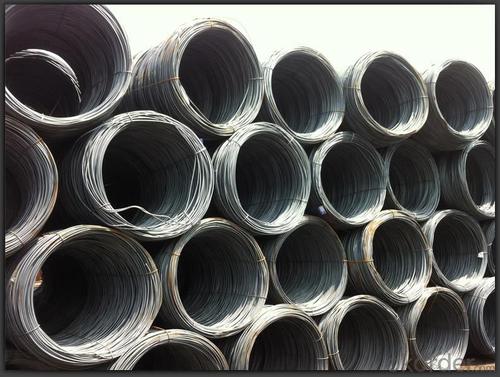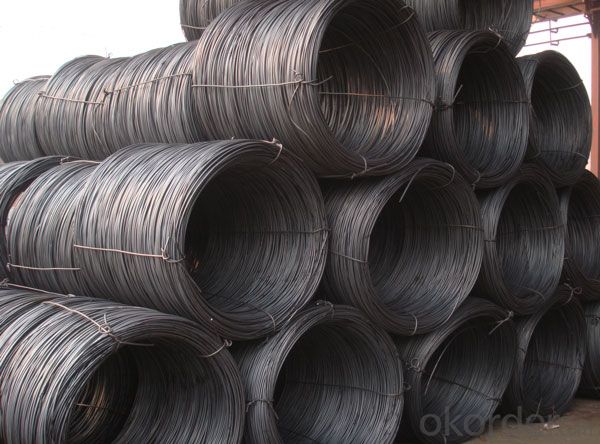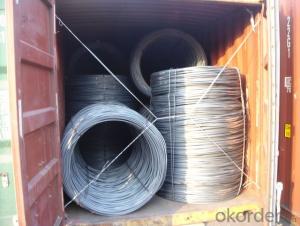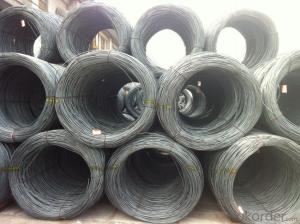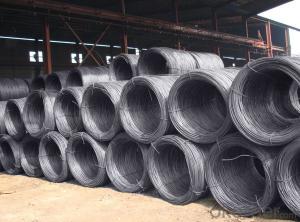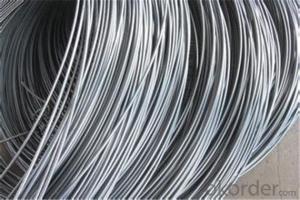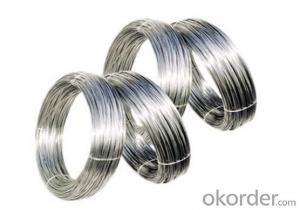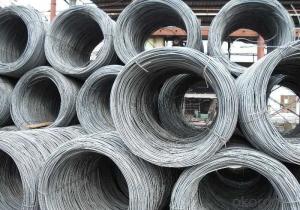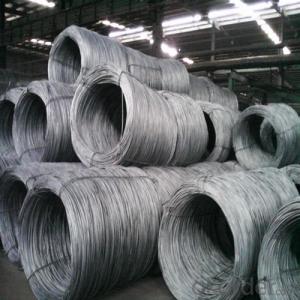Hot Rolled Wire Rod High Quality SAE 1006
- Loading Port:
- Shanghai
- Payment Terms:
- TT OR LC
- Min Order Qty:
- 25 m.t.
- Supply Capability:
- 200000 m.t./month
OKorder Service Pledge
OKorder Financial Service
You Might Also Like
Product Description:
OKorder is offering Hot Rolled Wire Rod High Quality SAE 1006 at great prices with worldwide shipping. Our supplier is a world-class manufacturer of steel, with our products utilized the world over. OKorder annually supplies products to European, North American and Asian markets. We provide quotations within 24 hours of receiving an inquiry and guarantee competitive prices.
Product Applications:
Carbon steel wire rod is widely used in construction and manufacturing. Carbon steel wire rod is mainly used for reinforcement of reinforced concrete and welded structure or reprocessed (roberts , nail, etc.) materials, especially used to produce wire drawing, welding electrode, nails, spring, electronic, precise machinery parts and so on.
Product Advantages:
OKorder's Hot Rolled Wire Rod High Quality SAE 1006 are durable, strong, and resist corrosion.
Main Product Features:
· Premium quality
· Prompt delivery & seaworthy packing (30 days after receiving deposit)
· Corrosion resistance
· Can be recycled and reused
· Mill test certification
· Professional Service
· Competitive pricing
Product Specifications:
Manufacture: Hot rolled
Grade: SAE1008 SAE 1006
Certificates: ISO, SGS, BV, CIQ
Diameter: 5.5mm, 6.5mm, 7mm,8mm,9mm,10mm,12mm,14mm, as per customer request
Packaging: Export packing, nude packing, bundled
Grade | Chemical Composition (%) | |||||
C | Mn | S | P | Si | B | |
SAE1008B | 0.10max | 0.32max | 0.045max | 0.040max | 0.30max | 0.0008min |
Mechanical properties | ||||||
Yield strength(N/mm2) | Tensile strength(N/mm2) | Elongation (%) | ||||
≥195 | 350-380 | ≥32 | ||||
FAQ:
Q1: The wire rod is added boron or chrom?
A1: We will choose to provide wire rod added chrom or boron according to the application of wire rod which the customer need.
Q2: How soon can we receive the product after purchase?
A2: Within three days of placing an order, we will begin production. The specific shipping date is dependent upon international and government factors, but is typically 7 to 10 workdays.
Q3: What makes stainless steel stainless?
A3: Stainless steel must contain at least 10.5 % chromium. It is this element that reacts with the oxygen in the air to form a complex chrome-oxide surface layer that is invisible but strong enough to prevent further oxygen from "staining" (rusting) the surface. Higher levels of chromium and the addition of other alloying elements such as nickel and molybdenum enhance this surface layer and improve the corrosion resistance of the stainless material.
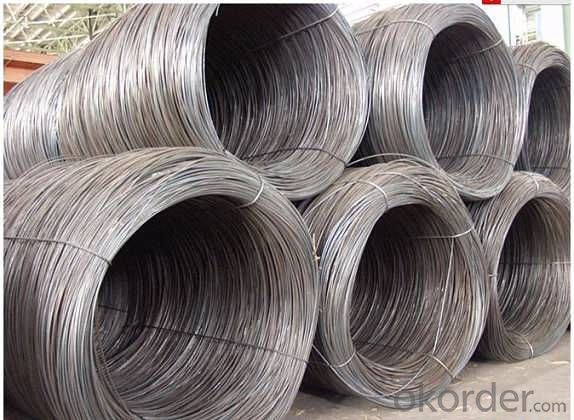
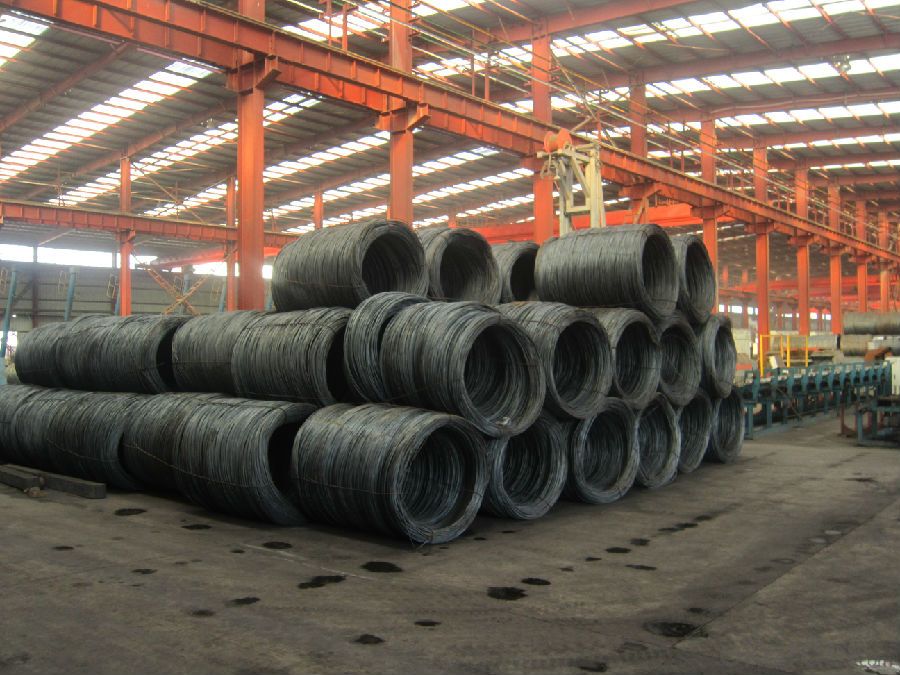
- Q: What are the different types of steel wire rod testing equipment?
- There are several types of steel wire rod testing equipment used to ensure the quality and performance of these materials. Some of the common types of equipment include: 1. Tensile testing machine: This equipment is used to measure the tensile strength of steel wire rods. It applies a pulling force on a sample of the wire rod until it breaks, allowing for the determination of the maximum amount of force the wire rod can withstand. 2. Hardness tester: This instrument measures the hardness of the steel wire rod, which is an important property for determining its strength and durability. There are various types of hardness testers, including Rockwell, Brinell, and Vickers hardness testers, which use different methods to assess the hardness of the material. 3. Ultrasonic testing equipment: Ultrasonic testing is a non-destructive method used to detect internal defects and flaws in steel wire rods. This equipment uses high-frequency sound waves to identify any abnormalities that may affect the quality and integrity of the material. 4. Dimensional measurement tools: These tools are used to measure the dimensions and tolerances of steel wire rods accurately. They can include devices such as micrometers, calipers, and gauges to ensure that the wire rods meet the required specifications. 5. Surface inspection equipment: This equipment is used to visually inspect the surface of the steel wire rods for any defects, such as cracks, scratches, or irregularities. Visual inspection can be done manually or with the help of automated systems that use cameras and computer algorithms to detect and analyze surface defects. 6. Chemical composition analyzer: This equipment is used to determine the chemical composition of the steel wire rods. It analyzes the presence and concentration of various elements, such as carbon, manganese, silicon, and others, to ensure that the wire rods meet the required composition standards. These are just a few examples of the different types of testing equipment used for steel wire rods. Each type plays a crucial role in ensuring the quality, strength, and performance of these materials in various industries, including construction, automotive, and manufacturing.
- Q: What are the common applications of pre-stressed concrete steel wire rod?
- Pre-stressed concrete steel wire rods are widely used in various applications due to their high strength and durability. Some of the common applications of pre-stressed concrete steel wire rods are: 1. Buildings and Infrastructure: Pre-stressed concrete steel wire rods are commonly used in the construction of buildings, bridges, highways, and other infrastructure projects. They provide added strength and load-bearing capacity to the structures, making them resistant to bending, cracking, and other forms of structural failure. 2. Post-tensioning Systems: Pre-stressed concrete steel wire rods are extensively used in post-tensioning systems. These systems involve the insertion of pre-stressed steel wire rods into concrete structures and then applying tension to them. This process helps to counteract the tensile forces that concrete structures experience, thereby improving their overall strength and durability. 3. Precast Concrete Products: Pre-stressed concrete steel wire rods are also used in the production of precast concrete products such as beams, columns, slabs, and walls. By incorporating pre-stressed steel wire rods during the manufacturing process, these products gain enhanced strength and resistance to cracking, allowing for longer spans and thinner sections. 4. Retaining Walls: Pre-stressed concrete steel wire rods play a crucial role in the construction of retaining walls. These walls are designed to retain soil and prevent erosion. By integrating pre-stressed steel wire rods into the concrete structure, the retaining walls become more robust, ensuring stability and preventing any potential failure due to the pressure exerted by the retained soil. 5. Seismic Resistant Structures: Pre-stressed concrete steel wire rods are especially valuable in seismic regions where earthquakes are a concern. By incorporating pre-stressed steel wire rods into the concrete elements of buildings and infrastructure, their ability to withstand seismic forces is significantly increased. This helps to minimize damage and ensure the safety of occupants during earthquakes. Overall, the common applications of pre-stressed concrete steel wire rods encompass a wide range of construction projects, where their strength, durability, and ability to withstand various forces are essential.
- Q: What are the different heat treatment options available for steel wire rod?
- There are several heat treatment options available for steel wire rod, each offering unique properties and characteristics. Some of the common heat treatment methods used for steel wire rod are: 1. Annealing: This process involves heating the steel wire rod to a specific temperature and then slowly cooling it down. Annealing helps in relieving internal stresses, improving machinability, and enhancing the ductility and toughness of the wire rod. 2. Normalizing: In this heat treatment method, the steel wire rod is heated to a temperature above its critical point and then cooled in still air. Normalizing helps to refine the grain structure, improve the mechanical properties, and enhance the overall strength and hardness of the wire rod. 3. Quenching and tempering: This two-step process involves first heating the steel wire rod to a high temperature and then rapidly cooling it in a quenching medium like water or oil. Quenching helps in achieving a high hardness, while tempering involves reheating the wire rod to a specific temperature and then cooling it down slowly. This process helps to reduce the brittleness and increase the toughness and ductility of the wire rod. 4. Case hardening: Also known as carburizing, this heat treatment method involves introducing carbon into the surface layer of the steel wire rod by heating it in a carbon-rich atmosphere. Case hardening provides a hard and wear-resistant outer layer while maintaining a tough and ductile core. 5. Stress relieving: This heat treatment option is used to reduce residual stresses that may have developed during manufacturing processes like cold working or machining. The steel wire rod is heated to a temperature below the critical point and then cooled slowly. Stress relieving helps to improve the dimensional stability and reduce the risk of distortion or cracking. These heat treatment options can be combined or used individually depending on the desired properties and applications of the steel wire rod. It is important to consider factors like the composition of the steel, desired hardness, strength, and other mechanical properties when choosing the appropriate heat treatment method for steel wire rod.
- Q: How are steel wire rods used in the manufacturing of wire brushes for cleaning purposes?
- Steel wire rods are an essential component in the manufacturing of wire brushes for cleaning purposes. These wire rods are typically made from high-quality steel, known for its strength, durability, and flexibility. To create wire brushes, the steel wire rods undergo a series of processes. First, the wire rods are carefully selected based on their composition and tensile strength. They are then passed through a wire drawing machine, which reduces their diameter and increases their length. This process allows for the creation of thin and long wires that are perfect for brush bristles. Once the wires are drawn, they are straightened and cut to the desired length. The lengths can vary depending on the type of brush being produced. The straightened wires are then inserted into a metal ferrule or twisted together to form a bundle, depending on the brush design. The wire bristles are then attached to a handle or base, which can be made of wood, plastic, or metal. This assembly process can be done manually or with the help of specialized machinery. The bristles are secured tightly to ensure they do not come loose during use. Steel wire rods are favored for manufacturing wire brushes due to their excellent cleaning properties. The strength and flexibility of steel allow the bristles to effectively remove dirt, grime, and debris from various surfaces. They can be used on a wide range of materials, including metal, wood, and concrete. Wire brushes made from steel wire rods are commonly used for cleaning applications such as removing rust, paint, or corrosion from surfaces, preparing surfaces for painting or welding, cleaning welding joints, and scrubbing hard-to-reach areas. They are also utilized in industries such as automotive, manufacturing, construction, and maintenance. In summary, steel wire rods play a crucial role in the manufacturing of wire brushes for cleaning purposes. Their strength, durability, and flexibility make them ideal for creating effective and reliable cleaning tools. Whether it's for removing rust, cleaning welds, or scrubbing surfaces, wire brushes made from steel wire rods are an essential tool in many industries and households.
- Q: What are the different types of steel wire rod coatings used for increased hardness?
- There are several different types of steel wire rod coatings that are used to increase hardness. These coatings are applied to the surface of the wire rod to enhance its strength, durability, and resistance to wear. Some of the commonly used coatings include: 1. Galvanized Coating: This is one of the most widely used coatings for steel wire rods. It involves applying a layer of zinc to the surface of the rod through a hot-dip or electroplating process. The zinc coating provides excellent corrosion resistance and increases the hardness of the wire rod. 2. Zinc-Aluminum Coating: This coating is a combination of zinc and aluminum, which provides enhanced hardness and corrosion resistance. It is applied through a hot-dip process, resulting in a coating that is more durable and longer-lasting compared to a regular galvanized coating. 3. Copper Coating: Copper coatings are used to improve the hardness and electrical conductivity of the steel wire rod. This type of coating is commonly employed in applications where electrical conductivity is crucial, such as in electrical wiring and grounding applications. 4. Nickel Coating: Nickel coatings are known for their excellent hardness and resistance to corrosion. These coatings are often applied to steel wire rods used in high-stress applications where wear resistance is critical, such as in springs, cables, and fasteners. 5. Chrome Coating: Chrome coatings are used to increase the hardness and wear resistance of steel wire rods. The process involves electroplating the rod with a layer of chromium, which provides excellent resistance to abrasion and corrosion. 6. Ceramic Coating: Ceramic coatings are relatively new in the field of steel wire rod coatings. These coatings consist of ceramic particles that are applied to the surface of the wire rod using specialized techniques like plasma spraying. Ceramic coatings offer exceptional hardness, wear resistance, and thermal stability, making them suitable for demanding applications such as cutting tools and industrial machinery. It is important to note that the selection of the appropriate coating for a specific application depends on factors such as the intended use, environmental conditions, and desired performance characteristics. Consulting with a materials engineer or coating specialist would be beneficial in determining the most suitable coating for increased hardness in steel wire rods.
- Q: What are the different physical properties of steel wire rod?
- Some of the different physical properties of steel wire rod include its high tensile strength, ductility, hardness, and resistance to corrosion. It is also known for its ability to conduct electricity and heat, as well as its malleability, which allows it to be easily shaped and formed into various applications.
- Q: What are the common defects that can occur during the processing of steel wire rod?
- Some common defects that can occur during the processing of steel wire rod are surface cracks, internal voids or inclusions, uneven dimensions, and incorrect chemical composition.
- Q: What are the common industry standards for steel wire rod?
- The common industry standards for steel wire rod include specifications such as diameter, tensile strength, chemical composition, and surface quality. These standards vary depending on the intended use of the wire rod, such as for construction, automotive, or industrial applications. Some widely recognized standards for steel wire rod include ASTM A510, DIN 17140, and JIS G3503.
- Q: What are the different types of wire mesh for architectural use made from steel wire rod?
- There are various types of wire mesh for architectural use made from steel wire rod, including welded wire mesh, woven wire mesh, expanded metal mesh, and perforated metal mesh. Each type offers different features and applications, providing architects with a range of options to suit their specific design requirements.
- Q: How is steel wire rod used in the manufacturing of suspension cables?
- Steel wire rod is commonly used in the manufacturing of suspension cables due to its high strength and durability. Suspension cables are essential components in various structures like bridges, suspension bridges, cable-stayed bridges, and suspension cable systems in buildings. These cables are responsible for carrying the load of the structure and ensuring its stability. Steel wire rod is the primary material used to make suspension cables because of its unique properties. The high tensile strength of steel wire rod allows it to withstand heavy loads and forces without breaking. This strength is crucial in suspension cables as they need to support the weight of the entire structure and resist the forces of wind, earthquakes, and other external factors. In the manufacturing process, steel wire rod is first drawn through a series of dies to reduce its diameter and increase its length. This process, called wire drawing, refines the steel wire rod and improves its mechanical properties. The resulting wire is then coated with a protective layer, such as zinc or epoxy, to prevent corrosion and increase its lifespan. After the wire has been processed, it is twisted together with other wires to form strands. These strands are further twisted together to create a cable. The number of strands and the arrangement of wires within the strands depend on the specific requirements of the suspension cable. Once the suspension cable is manufactured, it is installed and tensioned in the structure. The high strength of the steel wire rod ensures that the cable can withstand the applied tension and support the weight of the structure effectively. The durability of the steel wire rod also ensures that the suspension cable remains reliable and safe for an extended period. In summary, steel wire rod plays a vital role in the manufacturing of suspension cables due to its high strength, durability, and corrosion resistance. It is the primary material used to create these cables, ensuring their ability to support heavy loads and maintain the stability of various structures.
Send your message to us
Hot Rolled Wire Rod High Quality SAE 1006
- Loading Port:
- Shanghai
- Payment Terms:
- TT OR LC
- Min Order Qty:
- 25 m.t.
- Supply Capability:
- 200000 m.t./month
OKorder Service Pledge
OKorder Financial Service
Similar products
Hot products
Hot Searches
Related keywords



